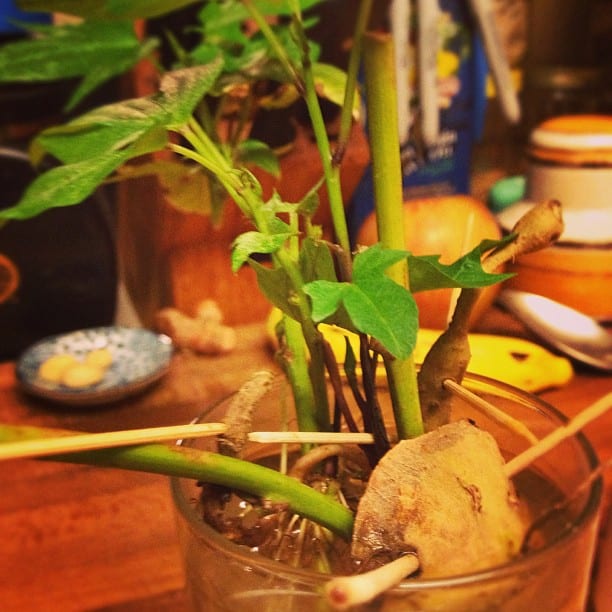
It’s true that sweet potatoes have a preference for warmer conditions, yet this preference doesn’t limit their cultivation exclusively to tropical regions.
While they do require approximately four months of warm temperatures to develop their full-sized tubers, their adaptability is rather surprising. The growth of sweet potato plants isn’t as demanding as one might assume, making them an accessible choice for gardeners.
With the right care and environment, they can be nurtured successfully across various climatic zones. Their versatility makes them a wonderful addition to gardens in regions that experience a wide range of temperature variations.
The cultivation process is remarkably straightforward, making sweet potatoes an excellent option for both experienced gardeners and newcomers.
Due to the unique nature of sweet potato vines, they exhibit an extraordinary ability to generate roots wherever they make contact with the soil. This inherent feature means that even a modest number of plants have the potential to yield a remarkable abundance during harvest time.

Additionally, for those working with limited garden space, there’s the option to explore bush varieties of sweet potatoes specifically tailored to accommodate smaller garden layouts. These varieties ensure that the rewards of cultivating sweet potatoes can be enjoyed regardless of the available gardening area.
There’s also an incomparable satisfaction in plucking a sweet potato straight from the ground and indulging in its natural freshness. It often possesses a richer and more vibrant flavor than its store-bought counterparts.
Incorporating homegrown sweet potatoes into your dishes contributes to better health. The nutrient content of fresh, organically grown produce is generally higher, and you have the added assurance of knowing exactly where your food comes from and how it’s grown.
Growing sweet potatoes empowers you with a degree of self-sufficiency. Reducing your reliance on store-bought produce and fostering a connection with the land can lead to a greater sense of accomplishment and autonomy.
Over time, the initial investment made in acquiring seeds or plants, as well as the necessary gardening supplies, can gradually translate into noteworthy savings when juxtaposed with the regular expenses associated with purchasing sweet potatoes from stores.
Unveiling the Secrets of Growing Sweet Potatoes
Contents
Sweet potatoes provide a wealth of important nutrients. They contain a good amount of fiber as well as vitamin A, vitamin C, manganese, and several other vitamins and minerals. They are quite nourishing.
Here’s how to grow sweet potatoes in your backyard:
1. Starting Sweet Potatoes From Slips
You can start with slips, which are sprouts from stored tubers. You can buy slips from garden centers, nurseries, or local farmers.
You can create your own slips by slicing a potato in half lengthwise. Place the halves on a bed of damp potting soil. Cover the pieces with a few inches of soil, taking care to keep them moist and warm.
You can also grow slips in a glass jar of water. You want half of the sweet potato underwater. The submerged part will grow roots and the part above water will grow sprouts.

(Photo: Macguys/Flickr)
If your sweet potato is too skinny you can use toothpicks to keep it from falling right down into the jar of water.
Small roots should develop within a few days. These will be followed by leaves. The slips are ready to be lifted and planted once they are between 4 and 8 inches tall.
Keep them in a sunny indoor spot until outdoor temperatures are warm enough for planting.
You should not attempt to plant it outdoors until the temperature of the soil has warmed to above 15°C. The plants will also need an air temperature of around 18.3°C to 35°C.
2. Planting Sweet Potatoes
Plant your sweet potatoes in warm soil that is rich in organic matter about a month after the last spring frost. The plants prefer full sun but will need some afternoon shade in hot, dry regions.
Experienced gardeners plant sweet potatoes in raised rows, about 8 inches high. This not only helps warm the soil faster but also facilitates good drainage.

Space plants are about 12 to 18 inches apart. Permit a space of about 3 to 4 feet between rows. The vines will spread. Give them plenty of room. If you are gardening in a cooler climate, spread black plastic on the soil to ensure sufficient warmth.
Water generously for a few days to make sure the plants root well. Once established, sweet potatoes will tolerate growing in dry soil. Still, it’s best to keep the patch evenly moist with an inch of water once a week.

3. Harvesting Sweet Potatoes
The tubers are ready to harvest in about four months. Don’t water your sweet potatoes during the final 3 to 4 weeks prior to harvest. This should help keep mature tubers from splitting.
If you like to eat the leaves as greens, you can do so in moderation throughout the season. But be sure to leave enough leaves to keep the plant growing.
You can dig your tubers once the foliage starts to yellow. Be gentle when digging. Sweet potato tubers grow close to the surface of the soil. Their skins are tender and easily damaged.
Are you ready to grow sweet potatoes in your backyard?

Backyard Sweet Potato Magic!
Unlock the swift path to backyard abundance, but in this journey of simplicity as you discover the secrets to cultivating these delectable tubers right at home. From plot to plate, harness nature’s magic in just three straightforward steps.
Whether you are a seasoned gardener or a novice, this guide empowers you to embrace the joys of homegrown sweetness without the hassle. So prepare to savor the fruits of your labor as you reap the benefits of your backyard efforts for these sweet potatoes.








